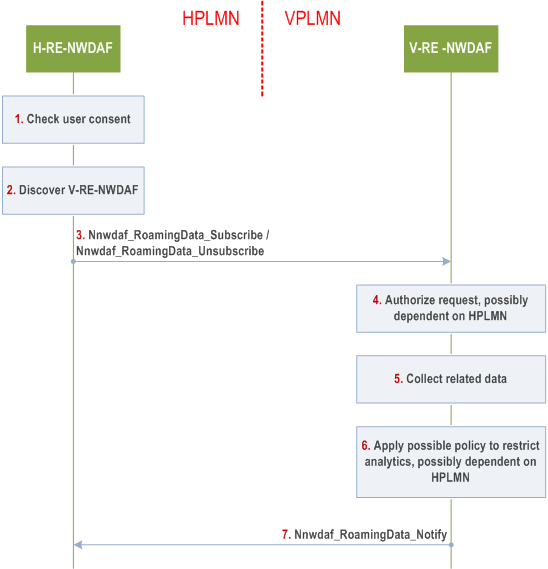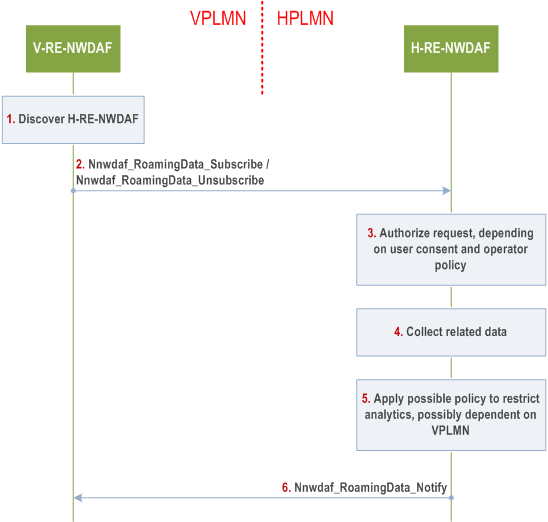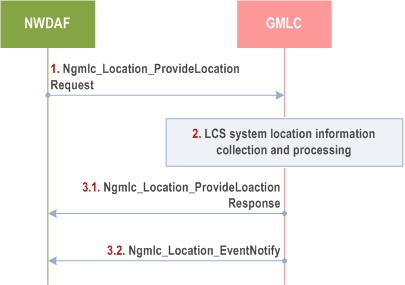Content for TS 23.288 Word version: 18.6.0
1…
4…
5…
5A…
6…
6.1.3
6.1.4…
6.1.4.4…
6.1.5…
6.1A…
6.1B…
6.1B.2.3…
6.1C
6.2…
6.2.3…
6.2.6…
6.2.6.2
6.2.6.3…
6.2.6.3.3
6.2.6.3.4
6.2.6.3.5
6.2.6.3.6…
6.2.7…
6.2.8…
6.2.9…
6.2.13…
6.2A…
6.2B…
6.2B.3
6.2B.4…
6.2C…
6.2D…
6.2E…
6.2F…
6.3…
6.4…
6.5…
6.6…
6.7…
6.7.3…
6.7.4…
6.7.5…
6.8…
6.9…
6.10…
6.11…
6.12…
6.13…
6.14…
6.16…
6.17…
6.18…
6.19…
6.20…
6.21…
7…
7.4…
7.7…
7.9…
8…
9…
10…
6.2.9 User consent for analytics
6.2.10 Data collection by H-RE-NWDAF from V-RE-NWDAF for outbound roaming users
6.2.11 Data collection by V-RE-NWDAF from H-RE-NWDAF for inbound roaming users
6.2.12 Data Collection using LCS
6.2.12.1 General
6.2.12.2 Procedure for data collection using LCS
...
...
6.2.9 User consent for analytics |R17| p. 112
Depending on local policy or regulations, to protect the privacy of user data, the data collection, ML Model training and analytics generation for a SUPI or GPSI, Internal or External_Group_Id or "any UE" may be subject to user consent bound to a purpose, such as analytics or ML Model training. The user consent is subscription information stored in the UDM, which includes:
EventExposure service with EventId "Number of UEs served by the AMF and located in an area of interest" and retrieves user consent for each SUPI. If a request for analytics is for an Internal or External Group Id, NWDAF resolves it into a list of SUPIs and retrieves user consent for each SUPI.
If user consent for a user is granted, then the NWDAF subscribes to user consent updates in UDM using Nudm_SDM_Subscribe service operation. Otherwise, the NWDAF excludes the corresponding SUPI from the request to collect data and generate analytics or ML Model on the other users for which user consent is granted if the request is for a group of UEs identified by an Internal-Group-Id or "any UE".
When data is collected from the UE Application, the ASP is responsible to obtain user consent to share data with the MNO.
If the UDM notifies that the user consent changed, then the NWDAF checks if the user consent is not granted for the purpose of analytics or model training. If user consent was revoked for a UE, the NWDAF stops data collection for that UE. For analytics subscriptions to UE related analytics with the Target of Analytics Reporting set to that UE, the NWDAF stops generation of new analytics and stops providing affected analytics to consumers. For ML Model subscriptions with Target of ML Model Reporting set to that UE, the NWDAF containing MTLF stops (re-)training of ML Model(s) using data from the UE and stops providing the ML Model(s) to consumers (NWDAF containing AnLF) for analytics. If the Target of Analytics Reporting or Target of ML Model Reporting is either an Internal or External Group Id or a list of SUPIs or "any UE", the NWDAF skips those SUPIs that do not grant user consent for the purpose of analytics or model training. The NWDAF may unsubscribe to be notified of user consent updates from UDM for users for which data consent has been revoked.
The Analytics ID that needs to check user consent before collecting input data are those that collect input data per user, i.e. per SUPI, GPSI, Internal or External Group Id, or those with the Target of Analytics Reporting or Target of ML Model Reporting set to a SUPI, GPSI or External or Internal Group Id and are described in clause 6.
- whether the user authorizes the collection and usage of its data for a particular purpose;
- the purpose for data collection, e.g. analytics or model training.
6.2.10 Data collection by H-RE-NWDAF from V-RE-NWDAF for outbound roaming users |R18| p. 113
This procedure may be used by the RE-NWDAF in the HPLMN as service consumer to subscribe/unsubscribe to notifications about input data from the VPLMN for outbound roaming users (from the HPLMN perspective). H-RE-NWDAF and V-RE-NWDAF in the procedure are NWDAFs with roaming exchange capability.

Step 1.
For subscription to collected data related to the UE(s), the H-RE-NWDAF checks the user consent of related users.
Step 2.
The H-RE-NWDAF of HPLMN discovers V-RE-NWDAF of VPLMN that supports the Nwdaf_RoamingData service using the NRF as specified in clause 5.2.
Step 3.
The H-RE-NWDAF subscribes/unsubscribes to notifications about input data by invoking the Nnwdaf_RoamingData_Subscribe / Nnwdaf_RoamingData_Unsubscribe service operation. It optionally may indicate the IDs of AMFs and for local breakout also SMFs in the VPLMN handling related UEs, as obtained from the UDM.
Step 4.
V-RE-NWDAF checks if the HPLMN is authorised to request the input data based on VPLMN operator polices (that may depend on the HPLMN and may indicate permissible or restricted input data and related parameters).
Step 5.
The V-RE-NWDAF triggers new data collection from NF(s) (as indicated via the AMF ID(s) or SMF ID(s)) if needed and monitors the requested input data using procedures as described in clauses 6.2.1 to 6.2.8.
Step 6.
The V-RE-NWDAF may restrict the exposed input data based on VPLMN operator polices (that may depend on the HPLMN) and may store them for auditing.
Step 7.
The V-RE-NWDAF notifies input data to the H-RE-NWDAF.
6.2.11 Data collection by V-RE-NWDAF from H-RE-NWDAF for inbound roaming users |R18| p. 115
This procedure may be used by an RE-NWDAF in the VPLMN to subscribe/unsubscribe to notifications about input data from the HPLMN for inbound roaming users (from the VPLMN perspective). H-RE-NWDAF and V-RE-NWDAF in the procedure are NWDAFs with roaming exchange capability.

Step 1.
The V-RE-NWDAF of VPLMN discovers H-RE-NWDAF of HPLMN that supports the Nnwdaf_RoamingData service using the NRF as specified in clause 5.2.
Step 2.
The V-RE-NWDAF subscribes/unsubscribes to input data information by invoking Nnwdaf_RoamingData_Subscribe / Nnwdaf_RoamingData_Unsubscribe service operation.
Step 3.
H-RE-NWDAF checks if the VPLMN is authorised to subscribe to the indicated input data based on HPLMN operator polices (that may depend on the VPLMN and may indicate permissible or restricted input data and related parameters) and user consent of related users.
Step 4.
The H-RE-NWDAF triggers new data collection if needed and monitors the requested input data, using procedures as described in clauses 6.2.1 to 6.2.8.
Step 5.
The H-RE-NWDAF may restrict the exposed input data based on HPLMN operator polices (that may depend on the VPLMN) and may store them for auditing.
Step 6.
The H-RE-NWDAF notifies input data to the V-RE-NWDAF.
6.2.12 Data Collection using LCS |R18| p. 116
6.2.12.1 General p. 116
The NWDAF may collect location information for a target UE or a group of target UEs using LCS. The collected location related information can include:
- Location estimate of the UE in geographical coordinates and/or local coordinates expressed as a shape as defined in TS 23.032 or local coordinate reference system;
- Time stamp of location estimate;
- Velocity of the UE as defined in TS 23.032;
- Information about the positioning method used to obtain the location estimate of the UE;
- Indication of area event, when UE enters, is within or leaves the Geographical area;
- Indication of motion event when UE moves by more than some predefined straight line distance from a previous location.
- Analytics ID (e.g. UE Mobility, QoS Sustainability, Relative Proximity, Movement Behaviour);
- Preferred granularity of location information.
6.2.12.2 Procedure for data collection using LCS p. 116
The interactions between NWDAF and LCS for data collection are illustrated in Figure 6.2.12.2-1. The data collected depends on the use cases. This figure is an abstraction of how NWDAF collects location information using LCS. The actual procedures that NWDAF may use are as follows:
- For a target UE, both 5GC-MT-LR procedure for the commercial location service as specified in clause 6.1.2 and deferred 5GC-MT-LR procedure as specified in clause 6.3 of TS 23.273 can be utilized;
- For a group of target UEs, bulk operation of LCS Service Request Targeting to Multiple UEs as specified in clause 6.8 of TS 23.273 can be utilized.

Step 1.
NWDAF requests the location information from GMLC about a target UE (that may be identified by a SUPI) or a group of target UEs (identified by a group ID).
Step 2.
GMLC interacts within LCS, i.e. with AMF/LMF as described in TS 23.273, to obtain the UE's location information. If privacy verification is required, GLMC will interact with UE via AMF before sending the location information to NWDAF.
Step 3.1.
If it is Immediate Location Request, GMLC sends the location service response including the location information for the target UE (or a group of target UEs) within a short time period as specified in clause 4.1a.4 of TS 23.273 to the NWDAF.
Step 3.2.
If it is Deferred Location Request, GMLC sends the location service response including the indication of event occurrence and location information if requested for the target UE (or group of target UEs) at some future time (or times) as specified in clause 4.1a.5 of TS 23.273 to the NWDAF.